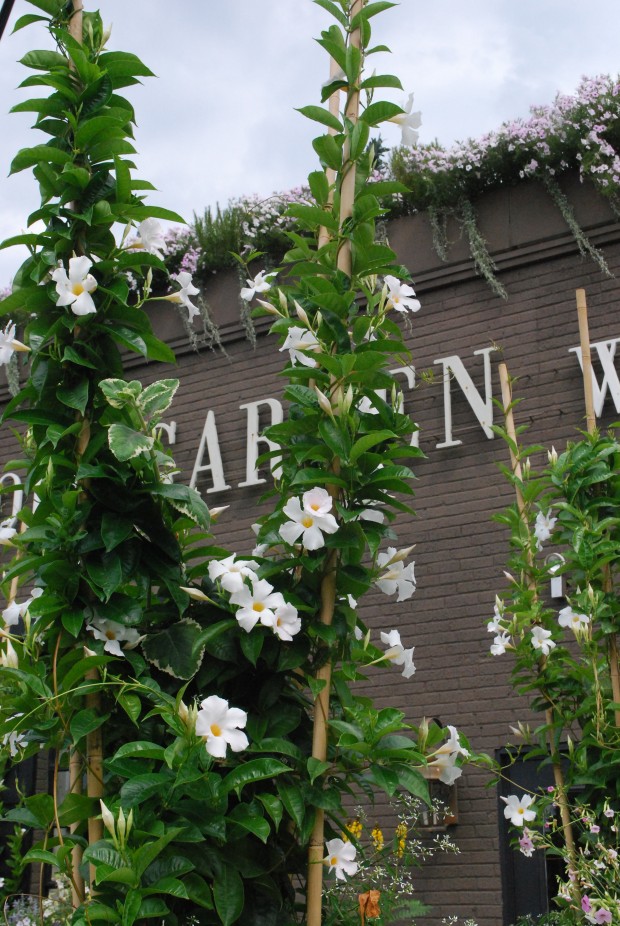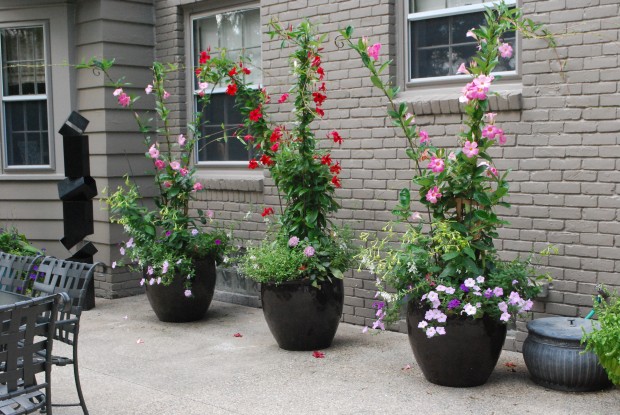The family of plants known as dogbane includes a genus of very handsome plants known as mandevillea. Mandevillea is a vining plant native to tropical climes-in central and South America. Michigan in no way resembles the tropics, but this vine is willing to perform here during the summer. Older forms of mandevillea, including the cultivar Alice du Pont, regrettably, are magnets for both insects and disease. In 2003, Suntory Flowers Ltd in Japan released a new series of mandevillea called Sun Parasol. Their breeding efforts produced plants with great vigor and disease resistance. Their near continuous bloom and ease of cultivation is as attractive as the flowers themselves.
Mandevilleas do require some sort of support to climb. This does not have to be fancy, since a well grown vine completely cover a pole, wire or trellis in short order. The vines do not attach themselves to a support, they wind around it. I have on occasion planted small mandevilleas as trailers in containers. Their natural inclination to curl gives them a very lively and wired appearance in a pot.
All six containers in the front of the shop have white mandevillea as their centerpiece. Additionally, the windowboxes at the shop are framed by white mandevillea vines. That decision was made long before the weather warmed up enough to plant. A cool and rainy summer would not have been so friendly to my choice. Mandevillea loves hot weather-the hotter, the better. They also like to be kept on the dry side. This summer-a perfect summer for them.
Mandevilleas only bloom on every third set of leaves. This means the look of the leaves is every bit as important as the flowers. The dark green, glossy, and healthy foliage is beautiful in its own right. My Jeannie le Joie climbing roses are a dream come true in the spring, but the foliage right now is nothing much to look at.
This week I have been catching up some of the plantings I did in May. I was happily surprised to see that every mandevillea we planted was growing strong. If I plant mandevillea as a centerpiece in a pot, I gradually remove its bottom leaves. Layering plants in a container requires some grooming, so one layer does not shade the other.
The dahlias in these pots are healthy and strong, but their peak bloom season will come in the fall. Of course the petunias have revelled in our heat just as much as the mandevillea. This mandevillea variety is simply known as Giant Pink.
4 10′ natural bamboo stakes provide support for the vine. We wind individual tendrils around each of the stakes, and tie them up with flexible garden tie. If new tendrils sprout from the base, or loose their grip on the pole, we may provide more ties. The Surfinia sky blue petunia in this pot-another outstanding annual cultivar bred by Suntory Flowers.
Red flowered mandevillea is an intense and deep crimson red. No so many summer flowering plants sport this color, but the Caliente deep red geraniums in this container come close. This vine is supported by 4 1/4″ diameter steel poles. The part of the pole that goes in the ground is straight. The upper part of the pole angles out slightly. We make these poles to mimic the natural growth of the plant. Once the vines reach the top, they can be left to their own devices.

What the small flowered cultivars lack in flower size, they make up for in sheer numbers. In another few weeks, these vines will be completely covered with flowers. Though I primarily use them in containers, they can be equally effective planted in the ground near a light post, railing, or fence.
The large flowered mandevilleas are slower to come into bloom than the smaller flowered cultivars, but if the warm season is long enough, they will catch up. Given how difficult our summer season has been, I really appreciate the breeding that has made this plant weather tolerant, florifierous, disease resistant, and easy to grow.
This is the hottest spot of any spot I garden. A stone terrace and brick wall facing south makes this terrace feel like the desert on a hot day. I see no signs of stress here whatsoever.
Mandevilleas are not tough to overwinter. The need a spot which does not dip much below 40 degrees. They will drop some leaves when brought in. I water them on occasion over the winter-not much. I do cut them back, but not much. They will need those stems to get going again in the spring.










